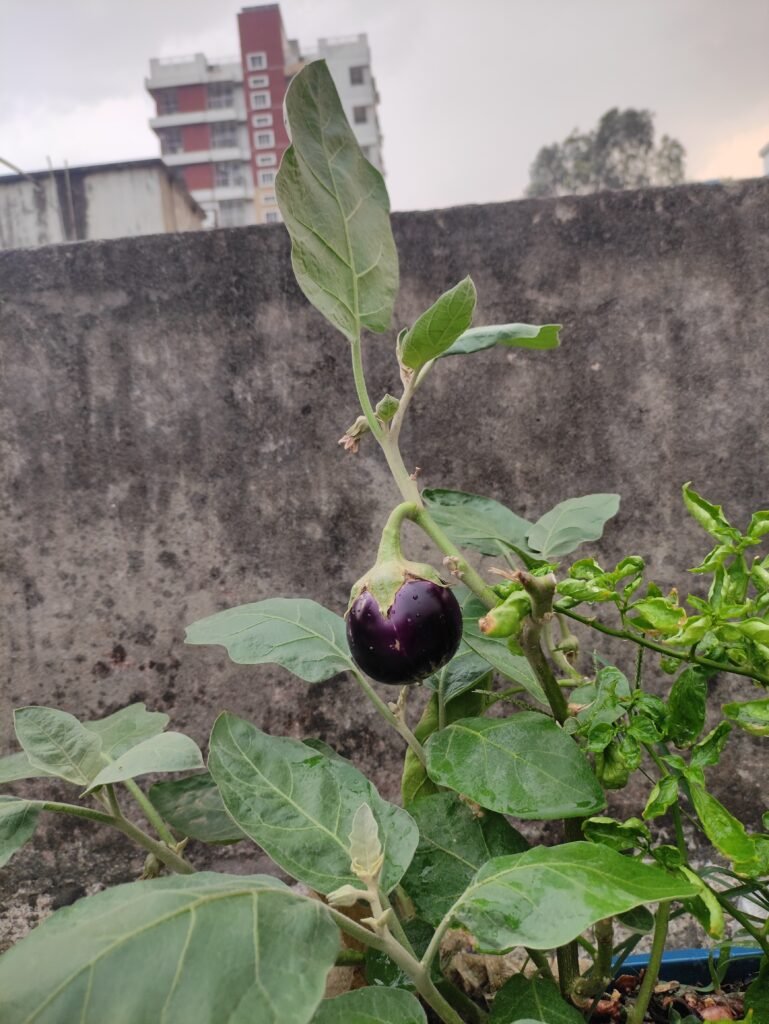How To Grow Eggplant/Brinjal in Containers (SEED TO HARVEST)

Various forms, colors, and shapes of brinjal are available in the market. You can choose according to your choice.
To start the seeds take a small pot with drainage holes at the bottom. Fill it with soil mix.
Sprinkle the seeds onto the surface of the soil mix. Separate closely packed or overlapped seeds to get better germination.
NOW lightly cover the seeds with the same soil mix and Gently press the soil with your hand to make good seed and soil contact.
SEED SOWING TIME: RAINY SEASON: JUNE – JULY
WINTER SEASON: OCT – NOV
SUMMER SEASON: FEB – MARCH
Water with a gentle shower so as not to dislodge the seeds. Now Keep the pot in a sunny spot and make sure that the soil remains a little moist at all times.
Brinjal grows wild in its homeland of South Asia as a perennial plant, through this warm season vegetables are treated as annuals. They grow fastest when the temperature is between 21 to 38 degrees Celsius (70-100 F).
Thanks to their broad leaves, eggplant seedlings grow quickly, gaining size faster than tomatoes or peppers. Prepare your eggplants for transplanting once the plants have reached at least 4-6 inches in height.
Carefully take out the seedlings with the help of a trowel or any gardening tool. Work the soil around the root ball and the seedling will come out easily without any damage. Always choose strong plants. Make sure that the root ball remains intact and does not get disturbed.
CONTAINER SIZE
For good harvest use a container that is at least 18 to 24 inches in diameter with 10-15 inches of depth will easily accommodate 3-4 plants.
Make sure to drill some holes at the bottom for drainage.
SOIL
Brinjal grows best in sandy loam soil, that is rich in nutrients, can hold moisture well, and is well draining at the same time. Compost provides your plant with the nutrients it needs, while the sand controls moisture. ( GARDEN SOIL+ COMPOST + SAND IN EQUAL RATIO) .
Drill 3-4 drainage holes at the bottom of the container. Drainage holes will allow excess water to leave the pot, minimizing the risk of root rot.
Make a 2-3 inch deep hole in the soil mix and gently put the root ball into the hole. Fill the hole with the soil mix and firm the soil with your hands to keep the seedling as upright as possible.
After transplanting seeds water them well.
From now onwards keep the soil a little moist at all times and for 2-3 days keep the pot in the shade to avoid transplant shock.
Planting multiple plants in a pot will also help in better pollination resulting in a huge harvest.
Yor can also grow brinjals in polybags. An 18-inch-diameter polybag can easily accommodate 2 plants. You can sow them as deep as possible as they tend to grow roots from the stem section. Planting them deep will result in a strong root system. Fill the hole with the soil mix and firm the soil with your hands to keep the seedling as upright as possible.
PINCHING
When the plants are small at that time you can pinch the top part to force the plants to branch out/ to grow fuller. This will also reduce the overall height of the plants and will keep them compact. Pinch just above a leaf node for better results.
FERTILIZATION
After every 12-15 days add organic compost such as cattle manure, vermicompost, and leaf mold. Add 2 handfuls per plant. You can also use seaweed fertilizer to feed ur plants ( Mix 35 – 45 ml in 10 litre water).
Work it into the first few inches of the soil with a gardening tool and add water immediately after adding fertilization to the soil. The addition of cattle manure of compost in the soil helps to add nutrients to the soil and also improves its water retention ability.
After 20-25 days from the transplant, brinjal plants will start producing buds and flowers.
WATERING
During hot days, your plants may even need multiple watering a day. If it looks dry then immediately add water. Allowing the soil to dry out will reduce the number of eggplants you can grow.
LOCATION
Brinjal plants will grow their best when kept in full sun. 5 to 7 hours of direct sunlight is required for healthy growth.
Usually, the first blossoms are not very attractive and do not yield fruit due to lack of pollination but with time fruit starts to form. If pollinators are absent or you have only a few plants, you can hand-pollinate them by dabbing a dry artist’s paintbrush in the open blossoms. Or, touch the back of the blossoms with a vibrating toothbrush to simulate a visit from a buzzing bee.
WATERING SCHEDULE
Brinjal requires evenly moist soil for its healthy growth. So, provide regular watering whenever the soil starts to dry up. During summers add water every day and in winters add water after every 2-3 days.
PESTS



Aphids, beetles, and spider mites are the main pests that affect the growth of the plant. These can be picked by hand and can be avoided with regular inspection of eggs on the plants. You can also use homemade pesticides to avoid pests and diseases.
To make your homemade pesticide mix 30ml neem oil + 20ml liquid dish soap + 20ml hot chilly extract/ 1 tablespoon chilly powder in 1 liter water. Spray after every 4-6 days to avoid pest and diseases.
As your plant starts to grow big, loosely tie the main stem to the stake using a twine/ thread. Trying the thread too tightly may get into the stem.
HARVESTING

Harvest brinjals young as soon as the skin becomes glossy. Your brinjals will be more tender and at this stage, their seeds are smaller. Cut fruits from the plant with a scissor or sharp pruner. Leave 1-2 inches of green stem attached to the fruit.
Plants will continue to produce for the next 2-3 seasons. They normally live for 8-12 months in total. Feed them regularly with organic compost for constant harvest.




